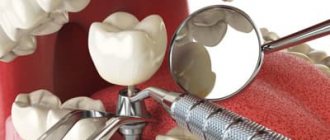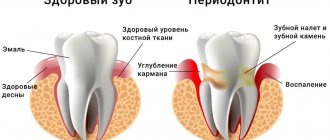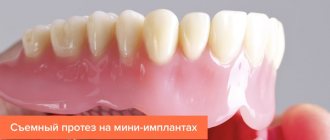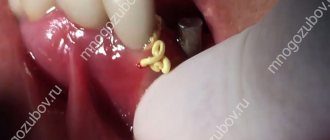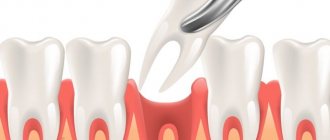Dental crowns are a popular and minimally invasive way to restore natural teeth. They are used when, for example, the crown of a living tooth is damaged by caries, mechanical trauma or previous root canal treatment. Thanks to prosthetic crowns, restored teeth look aesthetic, healthy and natural. When choosing a dental crown, patients at the Dental Brothers dental clinic often have questions about its strength, safety, and whether the crown can fall out.
Do you need a pin for a crown?
If the doctor insists on prosthetics, this already means that the tooth has undergone significant destruction. The crown helps restore the chewing function of the damaged unit and the aesthetics of the smile, this is especially true for the frontal region. Obviously, the prosthesis must have the necessary support. If there is a sufficient amount of natural tissue, the crown is placed directly on the tooth. In other cases, pins and stump inlays come to the rescue.
- Tooth decay of more than 30% is a good reason for installing a pin and crown.
- A chip of one of the walls of a tooth by 50% or more or a fracture at the root are indications for installing a core inlay and crown.
The technology also has limitations. A pin cannot be placed if there is untreated pulpitis, periodontitis and their complications (cyst, gumboil, etc.). Treatment will have to be abandoned if there are abnormalities in the structure of the tooth roots (too much curvature or thin walls). In some situations, the doctor is unable to unfill the canals after previous endodontic treatment, which also affects the possibility of installing a pin.
What will happen at the dentist's appointment?
At the patient's appointment, the doctor assesses the condition of the tooth root and stump. X-rays may also be required.
Temporary crowns
If there is significant tooth decay (more than 70%), the installation of temporary (provisional) crowns is indicated.
When the crown is not damaged, and the development of a carious process or any other pathological condition is not observed on the dental unit, the specialist immediately fixes the structure in place. If there are damages, therapeutic measures are taken to eliminate them and a new product is manufactured.
Events can develop in several directions, depending on the current situation:
- The flying crown is put back in place. To do this, at the first stage it is necessary to remove the remaining fixing material and treat the oral cavity with antiseptics. The methods used to prepare the tooth will depend on its condition. At the final stage, the structure is secured with dental cement.
- The dental unit is prepared for the creation of a new crown. In this case, the canals and tooth are treated again, defects are eliminated using special material, preparation and impression are made. It usually takes seven to ten days to produce a new product.
- The tooth is removed. This approach is provided in the case where there is complete destruction of the root and stump. The procedure is necessary, since a tooth that cannot be treated can provoke infection and the development of an inflammatory process. In this case, implants are used to restore the tooth after its complete removal. The procedure involves implanting a special screw made of metal into the bone tissue. After some time, when the element has taken root, an artificial prosthesis is fixed to it. This method is the most optimal, since in this case depulpation of adjacent dental units is not required. If implantation cannot be performed, which may be due to insufficient bone volume, then the patient is offered a single crown or bridge.
Many specialists provide a guarantee for their work. And if the crown falls off before the warranty period is still valid, then treatment measures are carried out, as a rule, free of charge at the expense of the clinic where the structure was originally installed. After the warranty expires, work is carried out at the patient's expense.
Inlay or pin: which is better?
The choice of support element depends on the specific clinical case. Both the pin and the core tab perform similar functions. However, each solution has its own advantages and disadvantages.
| Crowns on pins | Crowns on core inlays |
|
|
The stump tab is considered a more reliable option for chewing teeth and if it is necessary to install bridges. It is important to understand that this significantly increases the cost of treatment (the price per tab can reach up to 10,000 rubles). In addition, the manufacture of a stump insert requires an additional laboratory stage and appropriate manipulations.
Placing a crown on a pin can be recommended if the tooth does not have serious damage and there is no risk of pin breakage and root canal injury under the influence of chewing load. However, not all pins are suitable for the restoration of anterior teeth, especially if metal-free crowns are used. The crown and post on the front tooth should not contain metal if you want good aesthetics.
When installing a ceramic crown on a front tooth, the core inlay should also be made of ceramic.
What will the doctor do?
Which doctor is best to see if a dental bridge has fallen off? In general, dental prosthetics is the domain of an orthopedic dentist. If the prosthesis is on implants, then you will need to visit both an orthopedist and an implantologist, because The problem may be with the implant. Will the doctor be able to fix the old prosthesis? Here you will first need to undergo diagnostics, incl. tomography of the jaw, which will help determine the condition of the bone around the roots, the quality of root canal filling, and identify cracks in the roots.
Read on the topic: features of dental bridges - who is suitable for them, how they are made and installed.
If the support is in order and suitable for prosthetics, and the prosthesis itself has no flaws (i.e., the problem of falling out was only due to low-quality cement), then you can try to glue the old bridge in place. Of course, using new and high-quality cement.
If the doctor considers that the support needs treatment or removal, and also if the prosthesis is made incorrectly or is broken, then in addition to the main treatment, it will be necessary to make a new orthopedic bridge structure or, in principle, a different type of prosthesis.
Filling on a pin or crown: which is better?
This question interests many patients, and the answer is obvious. From the point of view of strength and reliability, the best option would be to install a pin and a crown. It is better to place a pin in a tooth under a crown in cases where the tooth is significantly damaged, especially when it comes to molars. A pin with a filling is installed for less significant damage and most often on the front teeth. This method also has its advantages. Firstly, this is a much cheaper technique. Secondly, all treatment takes place in one visit. The patient quickly returns to normal life and forgets about his problem. However, a filling with a pin gives a less reliable and predictable result.
Why is this happening?
So, what causes a denture or crown to fly off? In some cases, the cause may be external physical influences or other force majeure circumstances. However, most often the “dog is buried” in the poor quality of the dentist’s work.
Poor quality cementitious mixture . If its composition, quantity and application technology are violated, then over time the cement loses its properties, begins to crack and the crown falls out;
during the manufacture and installation of a prosthesis or crown were incorrectly calculated In other words, the shape of the supporting tooth and the internal plane of the artificial tooth do not coincide and the prosthesis begins to balance, destroying not only the cement fixation, but also the tooth itself.
What should a doctor take into account in order to properly install a crown or dental bridge? There are a number of points:
- features of bite;
- the extent of the defect, its configuration;
- correct treatment of teeth before installing a prosthesis;
- correctly calculated crown height and shape.
Stages of installing a crown on a pin
- Initial consultation, determination of indications and contraindications for treatment.
- Preparation of tooth tissues and depulpation of root canals.
- Installation of the pin.
- Taking impressions or 3D modeling. Sending the results to the laboratory to make a permanent crown. Immediately after the procedure, the patient is offered a temporary crown.
- Trying on the finished product and fixing the crown with a pin.
How does the crown stay in place?
Dental crowns made of any materials are fixed in the same way - with dental cement. In the process of preparing for prosthetics, the doctor:
- removes tooth tissue affected by caries;
- treats canals (if pulpitis has developed);
- mounts the pin of the crown part (in case of severe tooth decay);
- grinds the stump to give it the desired shape.
The last manipulation is crucial from the point of view of the correctness of prosthetics. Inside, the crown repeats the stump, outside - the height and geometry of the tooth being restored. Accurate reproduction of parameters directly determines the stability of the prosthesis. Thus, the quality of prosthetics depends on both the dentist and the dental technician.
While the permanent denture is being manufactured, the patient is offered a temporary plastic crown. It protects the remaining part of the tooth from damage and masks the gap well. While wearing a plastic crown, it is not recommended to eat too hard or sticky food.
Service life and design reliability
The service life of a crown on a tooth on a pin is quite decent if the treatment was carried out efficiently, and the patient avoided injury and followed the doctor’s recommendations. Even a classic metal-ceramic crown with a simple anchor pin costs on average 7–8 years. A more expensive ceramic crown on a fiberglass post will last even longer.
If during use the crown begins to wobble, then this is a bad sign, regardless of whether it is with a pin or without a pin. In this case, you need to consult a doctor as soon as possible. If the crown and pin fall out completely, this may be due to improper treatment, pathological processes in the root canals, or a banal injury. Repeated treatment in most cases is no longer possible.
How to temporarily stick a crown on a tooth
This is a very simple procedure that everyone can do:
- Apply a little special glue to the crown and install it in place (do not use super glue for this!). Be sure to read the instructions for using dental adhesive;
- Squeeze your jaw slightly to ensure that the crown is in the correct position;
- if excess adhesive appears as a result of squeezing, carefully remove it;
Be sure to go to the dentist!
It may not be possible to put the dental bridge in place. Therefore, save it until you visit your doctor. Try to limit the chewing load on the problem area.
How much does it cost to put a crown on a post?
The price of the finished solution directly depends on the materials of the pin and crown. The cost of a regular anchor pin is 500 rubles, but for a fiberglass one you will have to pay more than 1000 rubles. But these figures pale in comparison with the range of prices for crowns. If ordinary metal-ceramics costs 6–8 thousand, then products made of ceramics and zirconium will cost three times more. All preparatory manipulations will need to be added to the final amount.
An E-Max ceramic crown on a fiberglass pin, together with all stages of treatment, can cost 30,000 rubles and even more if we are talking about a VIP-class clinic. You can also choose a budget option with a metal-ceramic crown and an anchor or titanium pin. This solution will cost from 12,000 rubles, but is not suitable in all cases.
Reasons why a dental bridge may fall off
The integrity of the dental bridge is influenced by the following factors:
- The bridge was made to inaccurate measurements. Dentists believe that a bridge can only be made for five crowns and no more, otherwise the bridge design becomes unreliable.
- If the neighboring teeth that support the bridge are poorly prepared for prosthetics, this can also cause the bridge to fly off.
- Crowns for supporting teeth must be made of high-quality material, and they must be fixed with high-quality dental cement.
- Improper oral and dental hygiene. To keep your artificial teeth clean, you should have your teeth professionally cleaned twice a year. If this is not done, the period of wearing dentures will be greatly reduced.
Reasons for unscrewing an implant with a pin
dental implant with a pin gets twisted and
, which is quite rare, the main reason, as a rule, is a medical error or the use of a low-quality orthopedic structure for implantation.
Common causes of implant unscrewing:
- poorly performed antiseptic treatment;
- incorrectly selected system for installation with load calculation;
- inattentive study of the patient’s personal history.
Unscrewing of the implant 1-2 years after the implantation procedure can only occur due to the fault of the patient who did not follow all the recommendations of the attending physician for the care and use of the artificial tooth.
How to prevent the risk of tooth implant loss?
According to statistics, positive results from dental implantation are observed in 90-95% of cases. In order for the upcoming procedure for implanting a dental structure to be successful and not lead to complications, the patient needs to adhere to some recommendations.
Expert advice:
1. The most important thing at the stage of preparation for implantation is to choose a good dental clinic, where experienced implant dentists work, who have mostly positive reviews from patients.
2. Use high-quality implants from trusted global manufacturers for implantation.
3. Before the implantation procedure, it is necessary to conduct a full examination and sanitation of the oral cavity. Provide the doctor with all information about existing chronic diseases. An experienced dentist, having studied the patient’s complete medical history, will be able to foresee possible risks of complications and select the most suitable design for implantation, taking into account the characteristics of the patient’s body.
4. Do not refuse to install an implant from a trusted manufacturer if it is strongly recommended by the attending physician, even if the cost of the orthopedic structure exceeds the available budget. It’s better to pay more once, but solve the problem of missing teeth without adverse consequences.
5. Responsibly follow all doctor’s prescriptions and recommendations after installing an artificial tooth.
A tooth crown fell out, what should I do?
Of course, you should make an appointment with a doctor right away. But if the visit is postponed, for example, due to a business trip, vacation, or illness of the dentist, then the crown must be thoroughly rinsed. Remove the remaining cement and try to install it back. If the crown has become “shattered,” then the easiest option is to buy a temporary fixation agent at the pharmacy, dilute it according to the instructions and install the crown yourself.
Remember, this is a temporary measure.
, this method is only suitable for a few days; you cannot postpone the appointment. If pain, swelling, or fever occurs, you should seek emergency help.
If the restoration does not occupy the desired position or is in the way, then you should not use force to adjust it. This can cause tooth injury. In this case, the prosthesis needs to be washed, wrapped in a dry cloth and made an appointment with a doctor.
Why and when is extension needed?
The technique involves using dental material to fill in the missing area of the tooth. Based on this, extension is necessary in cases where there are corresponding defects. In this case, the technique will be effective both with minimal tooth abrasion and with significant destruction.
Main indications for extensions
Indications for extension are the following factors:
- Tooth decay due to various pathological processes, caries, traumatic injury;
- The need to correct any natural anomalies, including large gaps between teeth;
- Increased tooth wear;
- Unsatisfactory tooth size;
- Deterioration in tooth aesthetics due to fluorosis, when white spots on the tooth surface can only be corrected using this technique.
All these factors predispose a child to undergo tooth augmentation. Due to the mobility of children and frequent injuries, dentists most often have to build up their front teeth.
Extension techniques
There are several methods of teeth extension. Their choice is determined by the clinical situation and financial capabilities of the patient. Teeth extension using photopolymers is one of the most popular techniques. It is based on the unique properties of the material, its ability to harden only when exposed to light radiation. This allows the specialist to carry out all manipulations clearly and slowly. In addition to strength, complete restoration of aesthetic characteristics is ensured. Artificial fragments look the same as natural dental tissue. In addition, it will be possible to grow a tooth quickly and without harm to the enamel.
Extension using pins is a less preferable method, since the reliability of such a tooth is lower. However, since the procedure avoids tooth extraction and implantation, it also has every chance of being used. It involves installing a pin into the root canal of the tooth, placing a composite material around it and giving it the necessary shape.
An even more effective method is to preserve the tooth by installing an inlay, manufactured in a dental laboratory in accordance with the specified characteristics. This procedure is relevant when up to sixty percent of the hard tissue of a tooth or several of its walls is lost. Its implementation is within the competence of the orthopedic dentist.
Other orthopedic techniques are also relevant. Because severely damaged teeth lose strength and risk breaking completely, they are covered with crowns. Installing an artificial prosthesis allows you to evenly distribute the load on the tooth, extending its service life. In addition, crowns can be installed on teeth for aesthetic purposes. Particularly successful external characteristics will be achieved if ceramics are used to make the crown.
If there are prerequisites such as chips and cracks, the presence of a diastema, insufficient aesthetics of the front teeth, fluorosis, the situation can be improved with the help of orthopedic techniques, veneers or lumineers. These microprostheses are planned to be attached to the front tooth surface, which will completely change it, give it the desired shape and color.
Reasons for implant rejection
A weakening of the dental structure with its subsequent loss can be provoked by various factors associated with a doctor’s error or the fault of a patient who did not follow all the recommendations of the implant dentist.
A tooth implant fell out
– what can provoke:
1. Bone defects of the jaw. An experienced doctor will immediately identify existing disorders and warn the patient about the high risks of rejection.
2. Traumatic injuries that cause the structure to shift.
3. Failure to comply with high-quality oral hygiene and other doctor’s recommendations. After installation of an artificial tooth, the patient needs to take medications. If the patient ignores this prescription, an inflammatory process may occur, as a result of which the orthopedic structure will lose stability.
4. Doctor mistakes made during the surgical implantation of an artificial root.
5. The development of certain diseases in the patient’s body: diabetes mellitus, systemic disorders, malfunctions of the central nervous system, etc.
6. Implant rejection can occur due to individual intolerance to the material used to make the orthopedic structure.
7. Chronic periodontitis and other dental diseases.
8. Bad habits of the patient that slow down the engraftment process.
9. Excessive loads on the artificial tooth (chewing hard foods, opening bottles with teeth, etc.).
10. If a dental implant falls out in a dream
The patient probably suffers from bruxism (teeth grinding).
Complications leading to the loss of an artificial tooth can also arise due to an incorrectly selected structure for implantation. Some clinics offer patients installation of an implant at a very low price, which is due to the use of low-quality orthopedic designs. Such implants do not take root well, cannot withstand chewing loads and last a very short period of time.
